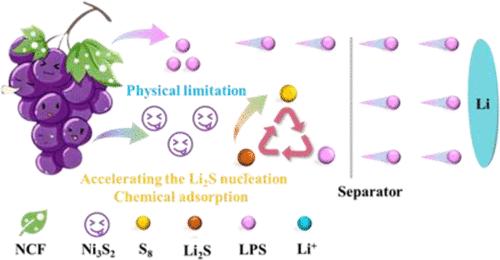Nitrogen-Doped Porous Nanofiber Aerogel-Encapsulated Staphylo-Ni3S2 Accelerating Polysulfide Conversion for Efficient Li–S Batteries
IF 8.2
2区 材料科学
Q1 MATERIALS SCIENCE, MULTIDISCIPLINARY
引用次数: 0
Abstract
The low conductivity of sulfur substances and the fussy effect of lithium polysulfides (LPS) limit the practical application of lithium–sulfur batteries (LSBs). In this work, Ni3S2 is in situ synthesized on N-doped 3D carbon nanofibers with an optimized pore structure as a cathode material for LSBs. The conductive carbon nanofiber skeleton with a hierarchical (micropore–mesopore–macropore) structure etched by Cd2+ can reduce the interface resistance of the cathode and remiss volume expansion during charge–discharge progress. The Ni was vulcanized and nitrogen-doped successively during the annealing process. In addition, the polar Ni3S2 and N-doped carbon structure can promote the catalytic conversion of LPS and regulate the 3D nucleation of Li2S, which could reduce the reaction energy barrier. Therefore, the NCF-Cd-Ni3S2-NC cathode can maintain a high initial capacity (1080.2 mAh g–1) and excellent stability at 0.1C. This work provides an important basis for the synthesis of high efficiency and inexpensive cathode carrier materials for LSBs.

氮掺杂多孔纳米纤维气凝胶封装的 Staphylo-Ni3S2 可加速多硫化物转化以制造高效锂离子电池
硫物质的低电导率和多硫化物锂(LPS)的模糊效应限制了锂硫电池的实际应用。本文在优化孔隙结构的氮掺杂三维碳纳米纤维上原位合成了Ni3S2作为lsb的正极材料。Cd2+蚀刻的具有微孔-中孔-大孔结构的导电碳纳米纤维骨架可以降低阴极的界面电阻,避免充放电过程中的体积膨胀。在退火过程中,Ni依次硫化和掺氮。此外,极性Ni3S2和n掺杂碳结构可以促进LPS的催化转化,调节Li2S的三维成核,从而降低反应能垒。因此,NCF-Cd-Ni3S2-NC阴极在0.1C时可以保持较高的初始容量(1080.2 mAh g-1)和优异的稳定性。本工作为合成高效廉价的lsdb负极载流子材料提供了重要的基础。
本文章由计算机程序翻译,如有差异,请以英文原文为准。
求助全文
约1分钟内获得全文
求助全文
来源期刊

ACS Applied Materials & Interfaces
工程技术-材料科学:综合
CiteScore
16.00
自引率
6.30%
发文量
4978
审稿时长
1.8 months
期刊介绍:
ACS Applied Materials & Interfaces is a leading interdisciplinary journal that brings together chemists, engineers, physicists, and biologists to explore the development and utilization of newly-discovered materials and interfacial processes for specific applications. Our journal has experienced remarkable growth since its establishment in 2009, both in terms of the number of articles published and the impact of the research showcased. We are proud to foster a truly global community, with the majority of published articles originating from outside the United States, reflecting the rapid growth of applied research worldwide.
 求助内容:
求助内容: 应助结果提醒方式:
应助结果提醒方式:


